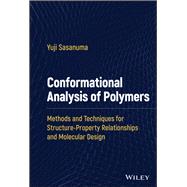Conformational Analysis of Polymers
Comprehensive resource focusing on theoretical methods and experimental techniques to analyze physical polymer chemistry
Connecting varied issues to demonstrate the impact on areas like biodegradability, environmental friendliness, structure-property relationship, and molecular design, Conformational Analysis of Polymers introduces theoretical methods and experimental techniques to analyze physical polymer chemistry.
Opening with a description of fundamental concepts and then describing the conformational characteristics of various polymers, including different heteroatoms and chemical species, the text continues onto the applications of density functional theory (DFT) to polymer crystals and structure-property relationships. The book concludes by bringing these issues together to demonstrate their practical impact on different areas of the field.
Various methods and techniques, including DFT, statistical mechanics, NMR, spectroscopy, and molecular orbital theory, are also covered.
Written by a highly qualified author, Conformational Analysis of Polymers explores sample topics such as:
- Fundamentals of polymer physical chemistry: stereochemistry of polymers, models for polymeric chains, Flory-Huggins theory, and rubber elasticity
- Quantum chemistry for polymers: ab initio molecular orbital theory, DFT, NMR parameters, and periodic DFT of polymer crystals
- Statistical mechanics of polymeric chains: basic rotational isomeric state (RIS) scheme, refined RIS method, inversional-rotational isomeric state method, and probability theory for RIS scheme
- Experimental techniques: NMR and scattering methods
Providing a timely update to the field of chain conformations of synthetic polymers and connecting fundamental theoretical approaches, experimental techniques, and case study applications; Conformational Analysis of Polymers is an essential resource for polymer chemists, physicists, and material scientists, industrial engineers who synthesize and process polymers, and academic researchers.








